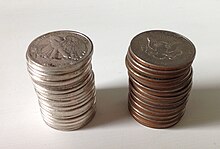
Back نيكل نحاسي Arabic Mis-nikel xəlitəsi Azerbaijani Cuproníquel Catalan Mědinikl Czech Kobbernikkel Danish Kupfernickel German Χαλκονικέλιο Greek Kupronikelo Esperanto Cuproníquel Spanish Kupronikkel Estonian

Cupronickel or copper–nickel (CuNi) is an alloy of copper with nickel, usually along with small quantities of other elements added for strength, such as iron and manganese. The copper content typically varies from 60 to 90 percent. (Monel is a nickel–copper alloy that contains a minimum of 52 percent nickel.)
Despite its high copper content, cupronickel is silver in colour. Cupronickel is highly resistant to corrosion by salt water, and is therefore used for piping, heat exchangers and condensers in seawater systems, as well as for marine hardware. It is sometimes used for the propellers, propeller shafts, and hulls of high-quality boats. Other uses include military equipment and chemical, petrochemical, and electrical industries.[1]
Another common 20th-century use of cupronickel was silver-coloured coins. For this use, the typical alloy has 3:1 copper to nickel ratio, with very small amounts of manganese.
In the past, true silver coins were debased with cupronickel, such as coins of the pound sterling from 1947 onward having their content replaced.
- ^ Sakiewicz P.,Nowosielski R., Babilas R. Production aspects of inhomogeneous hot deformation in as-cast CuNi25 alloy, Indian Journal of Engineering & Materials Sciences, Vol. 22, August 2015, pp. 389-398
© MMXXIII Rich X Search. We shall prevail. All rights reserved. Rich X Search